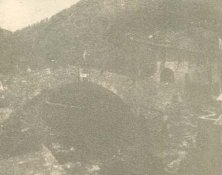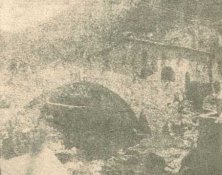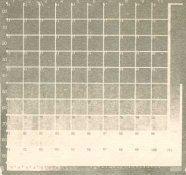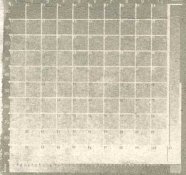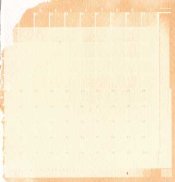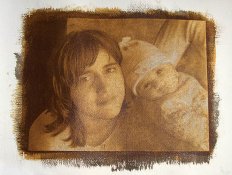Hi,
I have posted more than one time my experiences with gum bichromate printing... Last month I had some partial success. I don't know why suddenly I'm not making any progress. I'm keeping notes of everything I do and I don't know what happened.
The biggest problem I have is that the tonal range of my prints is extremely compressed. The tones jump from black to white in a very few steps. No matter if I adjust exposure. And even with digital negatives there's no change (I use Mark Nelson's system). It's black and white. Almost no greytones.
This happens with most colors, but it's especially noticeable with darker ones (lump black, mixtures of burnt sienna and blue, etc.). With lighter colors occasional flaking occurs sometimes. Natural earth pigments give me less evident problems.
I use MaimeriBlu pigments. I live in Italy and these are easy to find. They're the top line of Maimeri watercolors. About 5 dollars for a 15ml tube.
I use winsor & newton gum. It's expensive, but if I try to mix my own gum acacia (~30% in distilled water) I always experience problems (flaking most of the time).
I use potassium dichromate. Mine saturates at about 10-11%. I make a 12% solution to be sure it's saturated (there's a little bit of precipitate in the bottom of the bottle). I store the solution in a dark glass bottle. Lowering the concentration to 6% doesn't solve the problem.
I mix the gum and the pigment on the spot. I use a 1:1 gum:sensitizer ratio. I have tried 1:2 and 2:1, but the problems won't go away. I found that 0.50-0.75 g of pigment every 3 ml of gum and 3 ml of sensitizer (that is 0.50-0.75 grams every 6 ml of gum+sensitizer solution) give enough color density and dont' stain the paper. Above 1.0g I start getting stains or flaking.
I coat my paper with a hake brush. One quick coat, then I use a second clean brush to help me even the coating. I have tried sizing the paper. The problems persist with sized and unsized papers. I tried sizing the paper with food gelatin hardened by alum or by coating the paper with gum arabic and potassium dichromate (without pigment), exposing and washing. The only advantage by doing this was to get sometimes finer details due to a smoother surface.
My goal is to be able to make a decent print with a single coat and a good print with a wider tonal range with three coats or more. But I'm far from getting there...
I have posted more than one time my experiences with gum bichromate printing... Last month I had some partial success. I don't know why suddenly I'm not making any progress. I'm keeping notes of everything I do and I don't know what happened.
The biggest problem I have is that the tonal range of my prints is extremely compressed. The tones jump from black to white in a very few steps. No matter if I adjust exposure. And even with digital negatives there's no change (I use Mark Nelson's system). It's black and white. Almost no greytones.
This happens with most colors, but it's especially noticeable with darker ones (lump black, mixtures of burnt sienna and blue, etc.). With lighter colors occasional flaking occurs sometimes. Natural earth pigments give me less evident problems.
I use MaimeriBlu pigments. I live in Italy and these are easy to find. They're the top line of Maimeri watercolors. About 5 dollars for a 15ml tube.
I use winsor & newton gum. It's expensive, but if I try to mix my own gum acacia (~30% in distilled water) I always experience problems (flaking most of the time).
I use potassium dichromate. Mine saturates at about 10-11%. I make a 12% solution to be sure it's saturated (there's a little bit of precipitate in the bottom of the bottle). I store the solution in a dark glass bottle. Lowering the concentration to 6% doesn't solve the problem.
I mix the gum and the pigment on the spot. I use a 1:1 gum:sensitizer ratio. I have tried 1:2 and 2:1, but the problems won't go away. I found that 0.50-0.75 g of pigment every 3 ml of gum and 3 ml of sensitizer (that is 0.50-0.75 grams every 6 ml of gum+sensitizer solution) give enough color density and dont' stain the paper. Above 1.0g I start getting stains or flaking.
I coat my paper with a hake brush. One quick coat, then I use a second clean brush to help me even the coating. I have tried sizing the paper. The problems persist with sized and unsized papers. I tried sizing the paper with food gelatin hardened by alum or by coating the paper with gum arabic and potassium dichromate (without pigment), exposing and washing. The only advantage by doing this was to get sometimes finer details due to a smoother surface.
My goal is to be able to make a decent print with a single coat and a good print with a wider tonal range with three coats or more. But I'm far from getting there...



